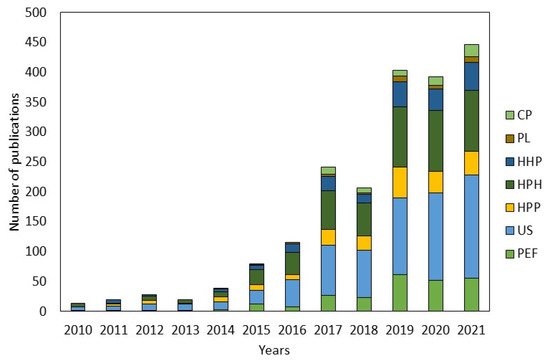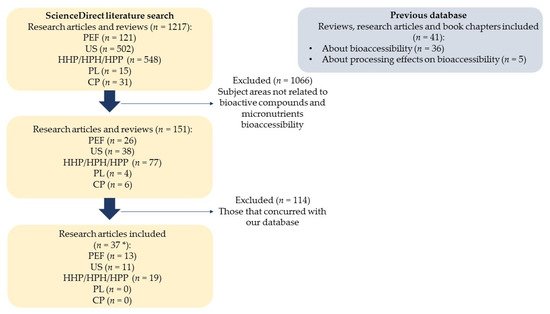Fruits and vegetables are rich sources of bioactive compounds and micronutrients. Some of the most abundant are phenols and carotenoids, whose consumption contributes to preventing the occurrence of degenerative diseases. Recent research has shown the potential of non-thermal processing technologies, especially pulsed electric fields (PEF), ultrasounds (US), and high pressure processing (HPP), to trigger the accumulation of bioactive compounds through the induction of a plant stress response. Furthermore, these technologies together with high pressure homogenization (HPH) also cause microstructural changes in both vegetable tissues and plant-based beverages. These modifications could enhance carotenoids, phenolic compounds, vitamins and minerals extractability, and/or bioaccessibility, which is essential to exert their positive effects on health. Nevertheless, information explaining bioaccessibility changes after non-thermal technologies is limited. Therefore, further research on food processing strategies using non-thermal technologies offers prospects to develop plant-based products with enhanced bioaccessibility of their bioactive compounds and micronutrients. In this review, we attempt to provide updated information regarding the main effects of PEF, HPP, HPH, and US on health-related compounds bioaccessibility from different vegetable matrices and the causes underlying these changes. Additionally, we propose future research on the relationship between the bioaccessibility of bioactive compounds and micronutrients, matrix structure, and non-thermal processing.
- phenolic compounds
- carotenoids
- minerals
- vitamins
- bioaccessibility
- pulsed electric fields
- high pressure processing
- ultrasounds
- in vitro digestion
- plant-based products
1. Introduction


2. Factors Affecting Bioaccessibility of Bioactive Compounds and Micronutrients
2.1. Carotenoids
2.2. Phenolic Compounds
2.3. Minerals
2.4. Vitamins
3. Summary
PEF, HPP, HPH, and US can cause permeability changes in cell membranes, which is directly connected to microstructural changes in whole matrices and particle size reduction in liquid matrices. Generally, this facilitates the release of carotenoids and phenolic compounds, which improves their bioaccessibility. On the other hand, particle size reduction can also facilitate the formation of a strong fiber network due to more interactions between fragments of cells, which increase the viscosity of the product (juices and purees) and entrap carotenoids avoiding their correct absorption. Little information is available about the effect of viscosity and pectin on phenolic bioaccessibility, but it has been suggested that phenol-fiber interactions play an important role.
The presence of oils in pulps or purees is beneficial to enhance carotenoids bioaccessibility, whereas its effect is still unknown for phenols bioaccessibility. Nonetheless, it has been reported that the combination between PEF or HPP and the presence of lipids could increase their bioaccessibility in liquid matrices. Therefore, the effect of processing on bioaccessibility would depend on the balance between compounds degraded or modified during processing and/or digestion and those that are protected by the matrix.
Structural properties of matrix are one of the most important factors determining bioactive compounds bioaccessibility. Hence, further studies about the effect of these technologies on viscosity, fiber, particle size, pectin properties, and microstructural characteristics would be necessary to develop non-thermal strategies to enhance bioactive compounds bioaccessibility and to understand the main causes of these changes. Finally, future research should also focus on shelf-life, quality-related enzyme activities, and consumer’s acceptance, given that processing may alter the typical flavor of the final product, their quality attributes, or their microbiological stability during storage.
The entry is from https://doi.org/10.3390/foods10071538
References
- Rodríguez-Roque, M.J.; Rojas-Graü, M.A.; Elez-Martínez, P.; Martín-Belloso, O. In vitro bioaccessibility of health-related compounds from a blended fruit juice-soymilk beverage: Influence of the food matrix. J. Funct. Foods 2014, 7, 161–169.
- Minekus, M.; Alminger, M.; Alvito, P.; Ballance, S.; Bohn, T.; Bourlieu, C.; Carrì, F.; Boutrou, R.; Corredig, F.M.; Dupont, D.; et al. A standardised static in vitro digestion method suitable for food—An international consensus. Food Funct. Food Funct 2014, 5, 1113–1124.
- Ribas-Agustí, A.; Martín-Belloso, O.; Soliva-Fortuny, R.; Elez-Martínez, P. Food processing strategies to enhance phenolic compounds bioaccessibility and bioavailability in plant-based foods. Crit. Rev. Food Sci. Nutr. 2018, 58, 2531–2548.
- Barba, F.J.; Mariutti, L.R.B.; Bragagnolo, N.; Mercadante, A.Z.; Barbosa-Cánovas, G.V.; Orlien, V. Bioaccessibility of bioactive compounds from fruits and vegetables after thermal and nonthermal processing. Trends Food Sci. Technol. 2017, 67, 195–206.
- Failla, M.L.; Chitchumroonchokchai, C.; Ishida, B.K. In vitro micellarization and intestinal cell uptake of cis isomers of lycopene exceed those of all-trans lycopene. J. Nutr. 2008, 138, 482–486.
- Nagarajan, J.; Ramanan, R.N.; Raghunandan, M.E.; Galanakis, C.M.; Krishnamurthy, N.P. Carotenoids; Elsevier Inc.: Amsterdam, The Netherlands, 2017; ISBN 9780128052570.
- Failla, M.L.; Chitchumroonchokchai, C. In vitro models as tools for screening the relative bioavailabilities of provitamin A carotenoids in foods. Harvest Plus Tech. Monogr. 2005, 3, 32.
- Granado-Lorencio, F.; Olmedilla-Alonso, B.; Herrero-Barbudo, C.; Pérez-Sacristán, B.; Blanco-Navarro, I.; Blázquez-García, S. Comparative in vitro bioaccessibility of carotenoids from relevant contributors to carotenoid intake. J. Agric. Food Chem. 2007, 55, 6387–6394.
- Sy, C.; Gleize, B.; Dangles, O.; Landrier, J.-F.; Veyrat, C.C.; Borel, P. Effects of physicochemical properties of carotenoids on their bioaccessibility, intestinal cell uptake, and blood. Mol. Nutr. Food Res. 2012, 56, 1385–1397.
- Tyssandier, V.; Lyan, B.; Borel, P. Main factors governing the transfer of carotenoids from emulsion lipid droplets to micelles. Biochim. Biophys. Acta 2001, 1533, 285–292.
- Mapelli-Brahm, P.; Corte-Real, J.; Meléndez-Martínez, A.J.; Bohn, T. Bioaccessibility of phytoene and phytofluene is superior to other carotenoids from selected fruit and vegetable juices. Food Chem. 2017, 229, 304–311.
- Schweiggert, R.M.; Mezger, D.; Schimpf, F.; Steingass, C.B.; Carle, R. Influence of chromoplast morphology on carotenoid bioaccessibility of carrot, mango, papaya, and tomato. Food Chem. 2012, 135, 2736–2742.
- Panozzo, A.; Lemmens, L.; Van Loey, A.; Manzocco, L.; Nicoli, M.C.; Hendrickx, M. Microstructure and bioaccessibility of different carotenoid species as affected by high pressure homogenisation: A case study on differently coloured tomatoes. Food Chem. 2013, 141, 4094–4100.
- Palmero, P.; Lemmens, L.; Ribas-Agustí, A.; Sosa, C.; Met, K.; De Dieu Umutoni, J.; Hendrickx, M.; Van Loey, A. Novel targeted approach to better understand how natural structural barriers govern carotenoid in vitro bioaccessibility in vegetable-based systems. Food Chem. 2013, 141, 2036–2043.
- Jeffery, J.L.; Turner, N.D.; King, S.R. Carotenoid bioaccessibility from nine raw carotenoid-storing fruits and vegetables using an in vitro model. J. Sci. Food Agric. 2012, 92, 2603–2610.
- Jeffery, J.; Holzenburg, A.; King, S. Physical barriers to carotenoid bioaccessibility. Ultrastructure survey of chromoplast and cell wall morphology in nine carotenoid-containing fruits and vegetables. J. Sci. Food Agric. 2012, 92, 2594–2602.
- Palafox-Carlos, H.; Ayala-Zavala, J.F.; González-Aguilar, G.A. The role of dietary fiber in the bioaccessibility and bioavailability of fruit and vegetable antioxidants. J. Food Sci. 2011, 76, 6–15.
- Cilla, A.; Bosch, L.; Barberá, R.; Alegría, A. Effect of processing on the bioaccessibility of bioactive compounds—A review focusing on carotenoids, minerals, ascorbic acid, tocopherols and polyphenols. J. Food Compos. Anal. 2018, 68, 3–15.
- Bohn, T. Dietary factors affecting polyphenol bioavailability. Nutr. Rev. 2014, 72, 429–452.
- Jakobek, L. Interactions of polyphenols with carbohydrates, lipids and proteins. Food Chem. 2015, 175, 556–567.
- Jakobek, L.; Mati, P. Non-covalent dietary fiber—Polyphenol interactions and their influence on polyphenol bioaccessibility. Trends Food Sci. Technol. 2019, 83, 235–247.
- Oliveira, A.; Amaro, A.L.; Pintado, M. Impact of food matrix components on nutritional and functional properties of fruit-based products. Curr. Opin. Food Sci. 2018, 22, 153–159.
- Thakur, N.; Raigond, P.; Singh, Y.; Mishra, T.; Singh, B.; Lal, M.K.; Dutt, S. Recent updates on bioaccessibility of phytonutrients. Trends Food Sci. Technol. 2020, 97, 366–380.
- Drago, S.R. Minerals. In Nutraceutical and Functional Food Components; Elsevier Inc.: Amsterdam, The Netherlands, 2017; pp. 129–157. ISBN 9780128052570.
- Briones-Labarca, V.; Venegas-Cubillos, G.; Ortiz-Portilla, S.; Chacana-Ojeda, M.; Maureira, H. Effects of high hydrostatic pressure (HHP) on bioaccessibility, as well as antioxidant activity, mineral and starch contents in Granny Smith apple. Food Chem. 2011, 128, 520–529.
- Cilla, A.; Barberá, R.; López-García, G.; Blanco-Morales, V.; Alegría, A.; Garcia-Llatas, G. Impact of Processing on Mineral Bioaccessibility/Bioavailability; Elsevier Inc.: Amsterdam, The Netherlands, 2019; ISBN 9780128141748.
- Khaneghah, A.M.; Bagher Hashemi, S.M.; Es, I.; Gholamhosseinpour, A.; Loizzo, M.R.; Giardinieri, A.; Pacetti, D.; Pourmohammadi, K.; Ferreira, D.S. Water-Soluble Vitamins; Elsevier Inc.: Amsterdam, The Netherlands, 2019; ISBN 9780128141748.
- Gironés-Vilaplana, A.; Villaño, D.; Marhuenda, J.; Moreno, D.A.; García-Viguera, C. Vitamins. In Nutraceutical and Functional Food Components; Elsevier Inc.: Amsterdam, The Netherlands, 2017; pp. 159–201. ISBN 9780128052570.
